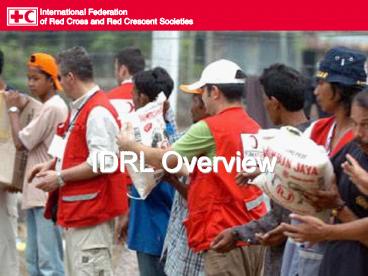IDRL Overview - PowerPoint PPT Presentation
1 / 15
Title:
IDRL Overview
Description:
UNDRO/OCHA. UNICEF. WFP. UNDP. ISDR. WMO. UNESCO ... WCO/OCHA Model Customs Agreement (1996) Codes and Standards. Red Cross/NGO Code of Conduct (1994) ... – PowerPoint PPT presentation
Number of Views:50
Avg rating:3.0/5.0
Title: IDRL Overview
1
IDRL Overview
2
Meaning of IDRL
- I International (Concerning foreign and
international actors) - D Disaster (natural man-made, but not armed
conflict) - R Response (preparedness, relief,
rehabilitation, reconstruction) - L Laws, rules and principles (National and
international)
3
IDRL Problems
- Demand Side
Supply Side
- Initiatition
- Visas
- Customs
- Medical qualifications
- Taxes
- Legal Personality
- Coordination
- Accountability
- Complementarity
- Quality of Assistance
4
Historical Developments
- 1758 Vattel, The Law of Nations
- 1863 International Committee for Relief
of the Wounded - 1869 2nd Intl Conference affirms RC
role in disasters - 1919 League of Red Cross Societies
- 1927 International Relief Union
De Vattel
Dunant
Ciraolo
5
International Relief Union
6
1984 Draft Convention
- Applied to states, IOs, NGOs
- Addressed issues of
- Visas
- Customs
- Transport
- Quality
- Liability
- ECOSOC did not adopt it.
7
Global Institutions
Bilateral Agreements
No Comphensive Legal Regime
Sectoral Law
Regional Law and Institutions
Soft Law
8
Bilateral Agreements
- Request and Response
- Entry of Personnel and Goods
- Costs
- Liability Issues
9
Global Institutions
NGOS
UNDRO/OCHA UNICEF WFP UNDP ISDR WMO UNESCO . . .
Federation ICRC 183 National Societies 20 million
active volunteers
Transnational Corporations
10
Sectoral IDRL
Basel Convention on Haz. Wastes (1989)
Kyoto Convention (1973)
Tampere Convention (1998)
Convention on Maritime Traffic (1965)
Nuclear Emergency Convention (1986)
Conventions on UN Privileges and Immunities (1946
1947)
Chicago Convention, Annex 9 (2004)
Framework Convention on Civil Defense (2000)
Int. Health Regs (2005)
11
Soft Law
- Resolutions
- Measures to Expedite International Relief (1977)
- GA Resolutions 46/182 (1991) and 57/150(2002)
- Hyogo Framework (2005)
Models UNITAR, Model Rules for Disaster Relief
Operations (1982) Max Planck Institute,
International Guidelines for Humanitarian
Assstance (1990) WCO/OCHA Model Customs Agreement
(1996)
Codes and Standards Red Cross/NGO Code of Conduct
(1994) Sphere Charter and Minimum Standards
(2000) Principles of Good Humanitarian Donorship
(2005)
12
Regional Law and Institutions
13
Customary IDRL?
- Cf. North Sea Continental Shelf Cases (1969)
- a very widespread and representative
participation in a convention might show that a
conventional rule had become a general rule of
international law - Tendency in practice to informally waive legal
barriers, at least at the outset of the disaster
14
Gaps at the International Level
- Non-binding nature of the most comprehensive
instruments - Binding instruments very specific and/or have few
parties - Wide variation of standards for different types
of provider (Govt, IGO, RC/RC, NGO) - Particularly big gap in quality/accountability
15
Gaps at the National Level
- Lack of awareness, application and codification
of international standards - Lack of detail in existing law
- Reliance on ad hoc rule-making
- Application of every-day rules to disaster
situations































